Summary
Theatre in early Melbourne was a vital part of community. Audiences were dazzled by the ambitious set designs of John Brunton, brought to the stage by Bland Holt’s immensely popular theatre company. Some model set pieces for plays such as The Breaking of the Drought have survived this whirlwind, finishing their journey within State Library Victoria’s walls. Careful conservation will allow this legacy to endure for many years to come.
Authored by Katy Glen, Conservator, Photography & Paper
Joseph Thomas (Bland) Holt (1851-1942) was a professional actor and producer from England who settled in Australia in 1876. Over the next two decades Holt and his second wife, actress Florence Anderson, became Australia’s favourite comedian stage couple. The Bland Holt Company staged meticulous and opulent comedy-melodramas and plays.
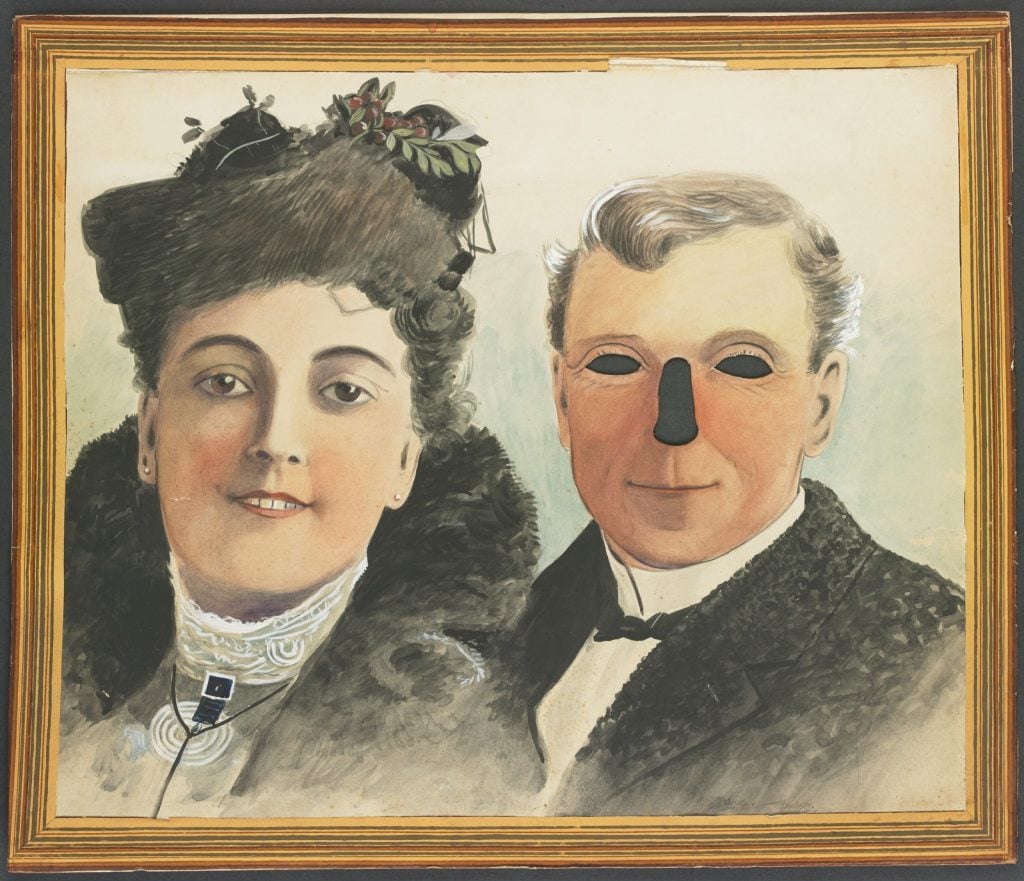
Bland Holt became known as the ‘King of Melodrama,’ famed for his productions’ spectacular effects – involving horses and hounds, balloon ascents, pigeons, diving feats – plus the first motorcar ever to be used on stage. Holt had a long-lasting collaboration with Scottish scenic artist John Brunton (1849-1909) whose work was ‘so beautiful that when the curtain went up, it was greeted with bursts of applause for the scenery itself.’1

Among Holt’s theatre successes was The Breaking of the Drought, a 1902 Australian play written by English playwright Arthur Shirley. The setting is contemporary. Jo Galloway, a squatter, lives at drought-stricken Wallaby Station in New South Wales with his wife and daughter, Marjorie. The son, Gilbert, is in Sydney training to be a doctor. Gilbert leads a fast life in the city, led astray by a fraudulent city financier who tricks him into squandering the family’s fortunes. Marjorie’s suitor, Tom Wattleby, rescues Gilbert from a bushfire and a heavy rain breaks the drought. In true melodramatic style, ‘the scapegrace son reforms, and the villain meets with his desserts.’2 The family’s idyllic pastoral livelihood resumes, and the wedding of Marjorie and Tom provides a happy ending to the saga.
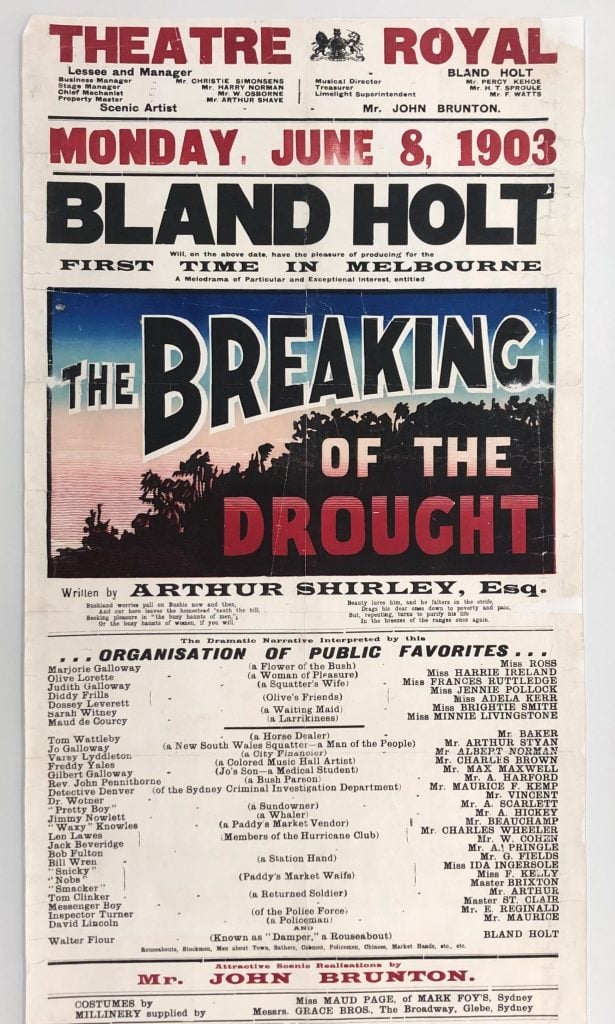
The play was very popular upon its debut at the Theatre Royal, located on the north side of Bourke Street. Rebuilt by entertainment entrepreneur George Coppin (1819-1906) after a devastating fire in 1872, the new theatre seated 4,000 people over four tiers and was described as ‘by far the most handsome and commodious yet seen in Australia.’3

By the turn of the century, Bland Holt’s realistic and sensational melodramas such as The Breaking of the Drought were staged to great acclaim. Brunton’s ambitious stage design, ‘a triumph of stagecraft,’4 blended evocative set pieces with real horses, swimming pools and trees.
‘The local scenes were much admired throughout, and the audience cheered loudly as the curtain rose on each new place…the bush fire, which was most realistic and effective, burning trees and falling timber covering the stage, and a horseman galloping up in time to save a man.’5
In 1920, Australian director and cinematographer Franklyn Barrett created a motion picture based on the popular play. The realism for which Holt’s productions were famed were truly the precursor of films! See the blog for more on the film.
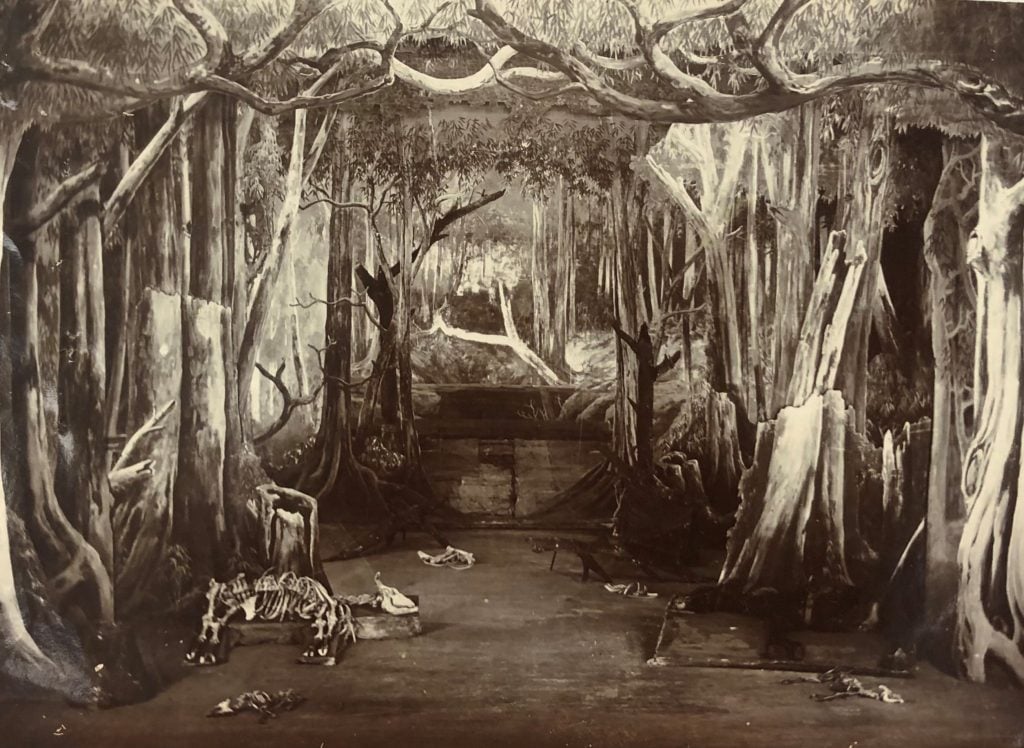
Conservation staff at State Library Victoria have become familiar with this rich period in the theatrical past of Melbourne, having treated numerous playbills and posters from the George Coppin collection. When several brown paper bundles arrived in the conservation laboratory, we were delighted to discover inside model set pieces for plays, including many scenes and acts from The Breaking of the Drought.

The model set pieces are fairly ‘rough and ready’ in terms of materials, design, and construction. There are many pencil underdrawings, and some heavily worked watercolour and gouache scenes, amongst random scribbles and much re-using of paper and card pieces.

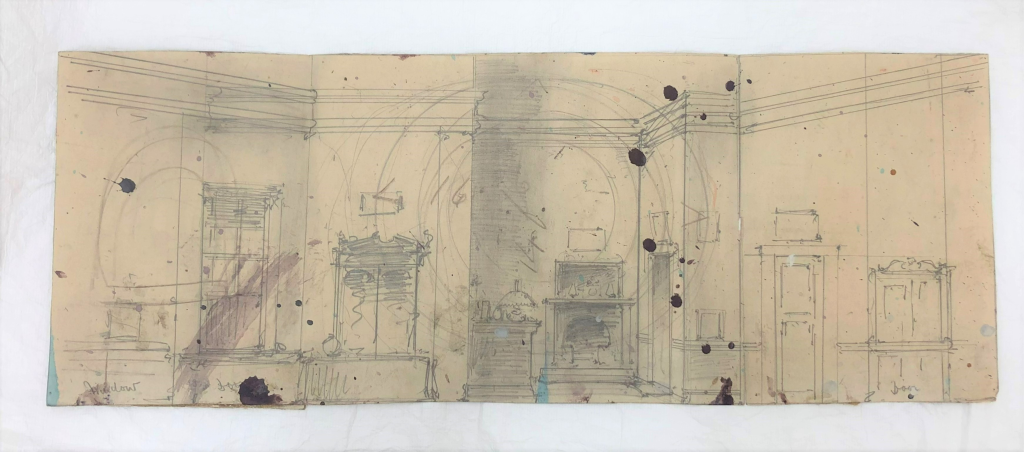
We presume these pieces were the initial inspiration of the set designer, upon which the life-size vision could be realised on the stage. Lucy Coppin, daughter of George Coppin, remembers how:
‘Mr John Brunton…would make a model stage for each production. Mr Holt would think round the production from every possible angle and tack it in place. Then Mr Brunton would paint the model as he intended to paint the scenery on the stage…The two of them would sit for hours discussing all sorts of details for the production.’6
As working objects these set pieces would have been used and moved and manipulated repeatedly.
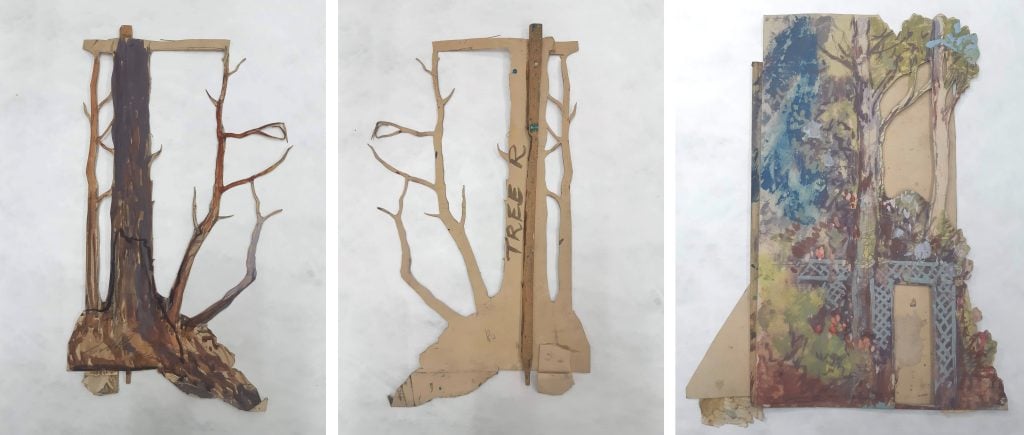
Some models retain their ability to function as a three-dimensional piece, while some models can only do so with assistance.

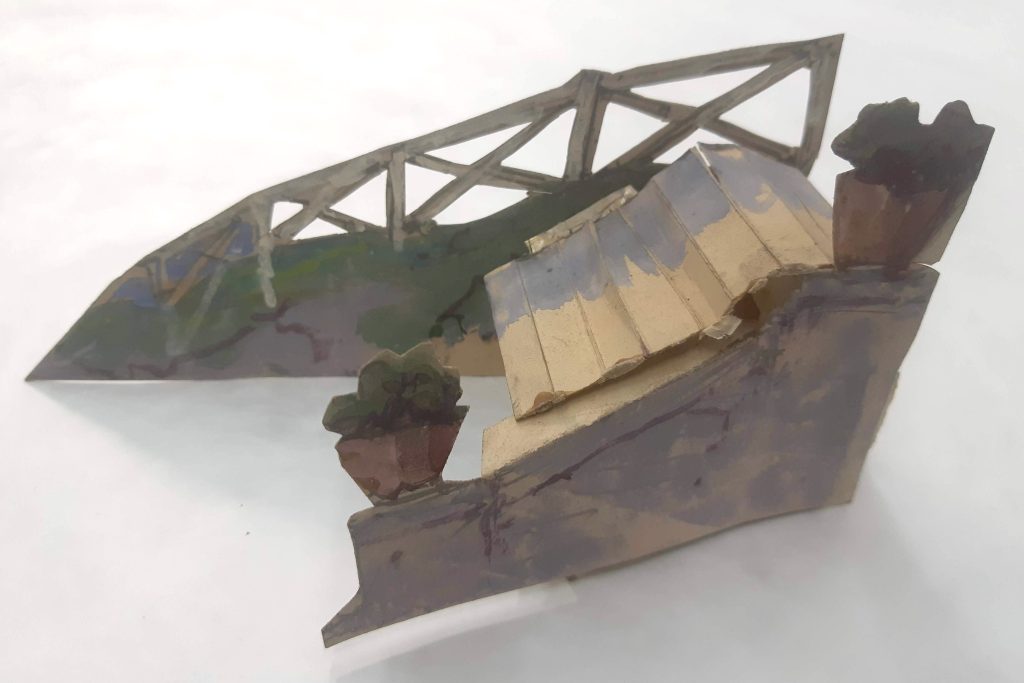

Other models are quite complex and too compromised to even be opened as originally intended. The one below is made up of 15 separate pieces attached together.

The bundles also include some elaborate renditions of scenery that served as backdrops for scenes.

Act 4 was set in a ‘Club,’ and the colourful set pieces included in this brown paper bundle suggest a rich and sumptuous staging of scenes, where intrigue and melodrama would undoubtedly unfold.

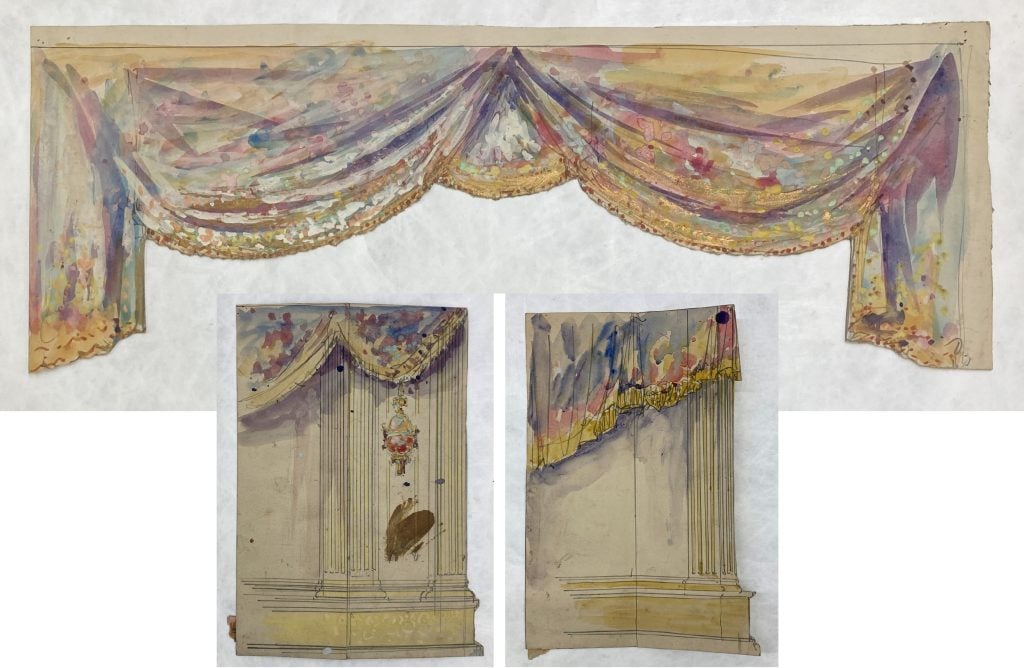
It was decided that treatment should be minimal, considering the complex nature of each set model piece and the risk of compounding current tensions. Also, we did not want to alter the rudimentary character that is essential to the set pieces. If necessary, a more interventive approach could be considered in the future. For example, removing the failing animal glue and replacing it with a more flexible adhesive to enable activation of the moving parts.
Conservation treatments always start with documentation. This is a way to gain a comprehensive understanding of the object, as much as to provide a detailed description of its materials and condition. In this case the task was made more complex by the many different parts within each bundle, ranging from nine to 24.
For each bundle all the model parts were separated out, reuniting loose pieces where possible, and rehoused them in individual archival plastic sleeves with support boards. The models are heavily embellished with graphite, so any surface cleaning was conservative, taking care not to disturb any media.

Any detached or loose pieces were reattached using wheat starch paste. Areas of damage that might worsen upon handling and further compromise the piece were repaired or reinforced using wheat starch paste and archival Japanese kozo paper.
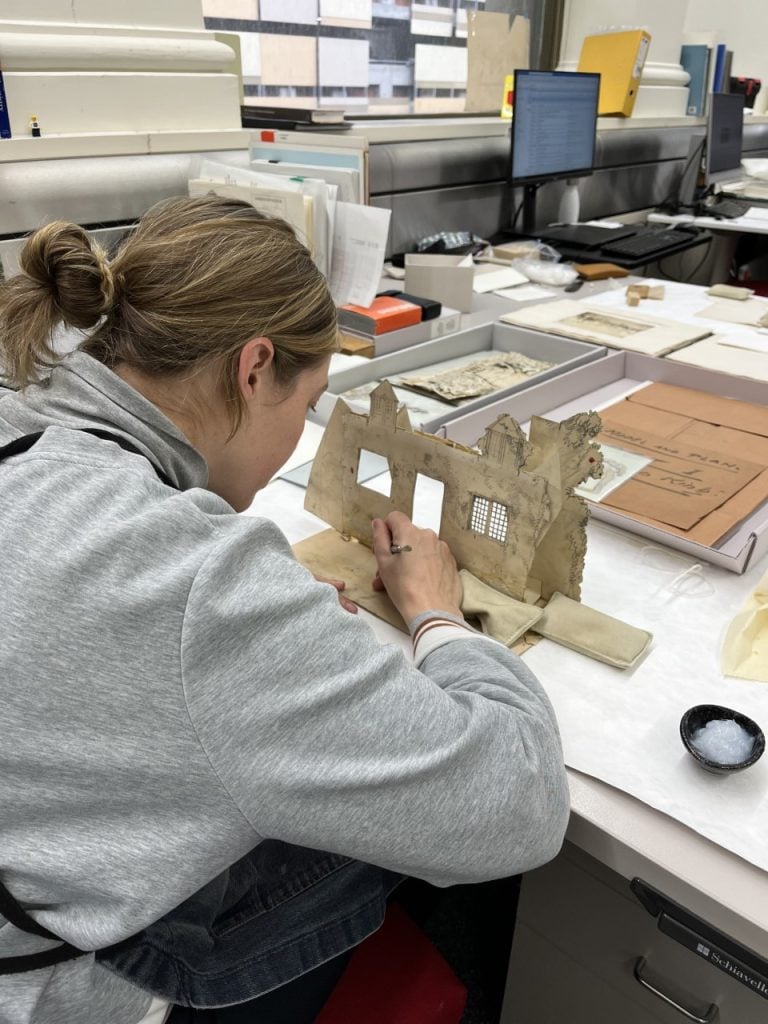
Once all the model pieces had been documented, stabilised and arranged in individual archival plastic pockets, custom boxes were constructed for their ongoing protection in storage.
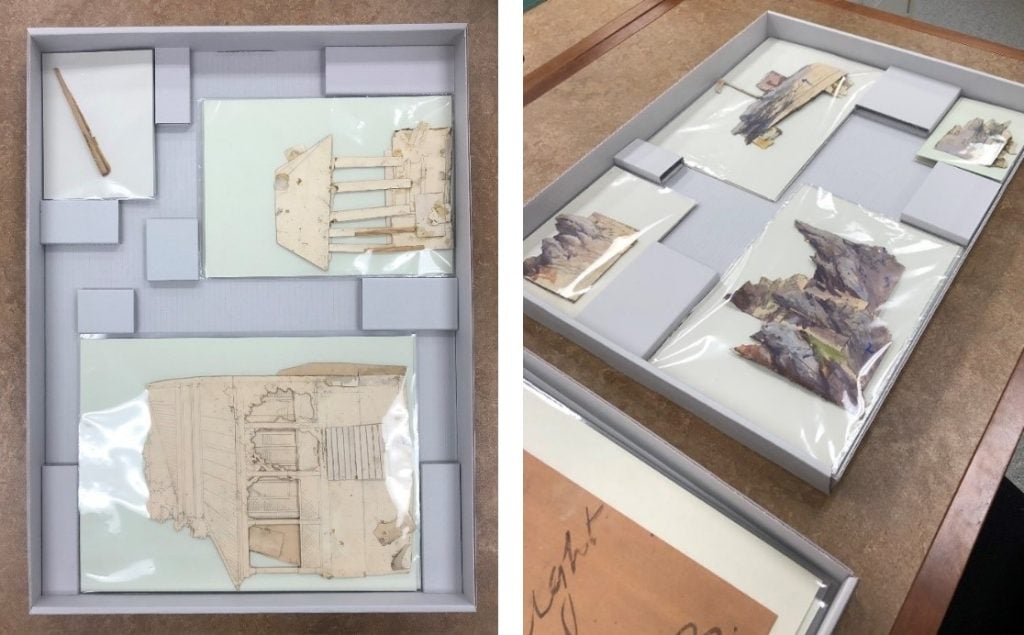
Future digitisation of the collection will enable the public to access the various model set pieces and peek behind the scenes of one aspect of Melbourne’s rich theatre legacy that has until now been, literally, under wraps.
- 1953 Memoirs of Australian Theatre, Coppin, Lucy M., MS Box 968/5(d), p.57
- 1902 ‘Lyceum Theatre – “The Breaking of the Drought,”‘ The Sydney Morning Herald (NSW: 1842-1954), 27 December, p.8, viewed 17 October 2023, https://trove.nla.gov.au/newspaper/article/14512866#
- 1872 ‘THE STAGE.’, Weekly Times (Melbourne, Vic.: 1869-1954), 9 November, p.9 (TOWN EDITION), viewed 9 August 2023, http://nla.gov.au/nla.news-article220449445
- 1902 ‘Lyceum Theatre – “The Breaking of the Drought,”‘ The Sydney Morning Herald (NSW: 1842-1954), 27 December, p.8, viewed 17 October 2023, https://trove.nla.gov.au/newspaper/article/14512866#
- 1902 ‘Lyceum Theatre – “The Breaking of the Drought,”‘ The Sydney Morning Herald (NSW: 1842-1954) 27 December, p.8, viewed 17 October 2023, https://trove.nla.gov.au/newspaper/article/14512866#
- 1953 Memoirs of Australian Theatre, Coppin, Lucy M., MS Box 968/5(d), pp.74-75


What a magnificent display. I applaud SLV for recognising the set crew. These artists are the most superior of all. To magically develop and transform a thought idea on to paper in seconds can only be the work of a master. I value the set artist as a perfectionist. Standing head & shoulders above the rest.
The ‘Hurricane Club’ sounds fun and just the sort of place for a ‘larrikiness’!
Congratulations Katy Glen! What a wonderful account of the fantastic work which is carried out in our Conservation Section. And what a triumph to bring into the light of day some of the hidden treasures from the Coppin Collection.
Many thanks,
Mary Lewis (former librarian Pictures Collection)